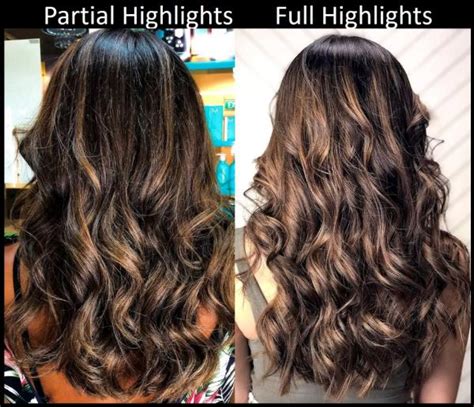When it comes to hair highlighting, the choice between partial and full highlights can be a game-changer. Each technique offers unique benefits and drawbacks, making it crucial to understand their differences before taking the plunge.

Partial Highlights: A Subtle, Sun-Kissed Touch
Definition: Partial highlights involve selectively adding color to a small portion of your hair, typically around the face and crown.
Pros:
- Subtle, natural-looking results: Partial highlights create a sun-kissed, lived-in look that blends seamlessly with your natural hair color.
- Less maintenance: With fewer highlighted strands, touch-ups are less frequent than with full highlights.
- Suitable for all hair types: Partial highlights work well on both fine and coarse hair, providing volume and dimension without overwhelming your locks.
Cons:
- Limited impact: Partial highlights offer a less dramatic transformation than full highlights.
- Potential for unevenness: If not done carefully, partial highlights can result in uneven hair color distribution.
Full Highlights: A Bold, Statement-Making Look
Definition: Full highlights involve adding color throughout the entire head of hair, from root to tip.
Pros:
- Dramatic transformation: Full highlights create a striking, high-contrast look that instantly transforms your appearance.
- Even distribution: Color is evenly distributed throughout your hair, resulting in a polished, salon-quality finish.
- Perfect for dark hair: Full highlights are an excellent way to add brightness and dimension to dark hair, creating a stunning contrast.
Cons:
- Higher maintenance: Full highlights require frequent touch-ups to maintain their vibrancy.
- Potential damage: Full highlights can put a strain on your hair, especially if harsh chemicals are used.
- Not suitable for all hair types: Fine or damaged hair may not be able to handle the stress of full highlights.
The best way to determine which technique is right for you is to consider your desired results, hair health, and lifestyle.
Suitable for Partial Highlights:
- Those seeking a subtle, sun-kissed look
- Individuals with fine or damaged hair
- Those who prefer less maintenance
Suitable for Full Highlights:
- Those desiring a bold, transformative look
- Individuals with dark hair
- Those who are willing to commit to frequent touch-ups
Cost Comparison
According to recent industry reports, the average cost of partial highlights ranges from $100 to $150, while full highlights typically cost between $150 and $250. The price can vary depending on factors such as hair length, density, and the salon you visit.
Partial Highlights: Touch-ups are recommended every 10-12 weeks to maintain the color and vibrancy. Use color-protecting shampoos and conditioners to prevent fading.
Full Highlights: Touch-ups are required every 6-8 weeks to prevent roots from becoming visible. Utilize deep conditioning treatments to keep your hair healthy and nourished.
- Consult a reputable salon with experienced hair stylists who specialize in highlighting.
- Bring inspiration photos to convey your desired look.
- Discuss your hair history, allergies, and lifestyle with the stylist.
- Request a strand test to ensure the color and technique are suitable for your hair.
Whether you prefer the subtle elegance of partial highlights or the bold statement of full highlights, there’s a technique that can elevate your hair and boost your confidence. By understanding the differences between the two, you can make an informed decision that complements your individual style and hair health needs. Embrace the transformative power of highlighting and enjoy radiant, eye-catching locks.
“Micro-Highlights” for a Balanced Blend
Micro-highlights are a recent innovation that combines the techniques of partial and full highlights. Smaller, more diffused strands are colored, resulting in a seamless, blended effect that adds depth and dimension to your hair.
“Reverse Highlights” for a Creative Twist
Reverse highlights involve lightening darker strands of hair to create a unique, dimensional look. This technique is ideal for those with naturally dark hair who desire a subtle, yet noticeable transformation.
“Foilayage” for Vibrant, Low-Maintenance Color
Foilayage is a highlighting technique that uses foils and bleach to create a natural-looking, multi-tonal effect. It offers a long-lasting, low-maintenance color solution that adds vibrancy and movement to your hair.
| Partial Highlights | Full Highlights |
|---|---|
| Subtle, natural-looking results | Bold, transformative look |
| Less maintenance | Higher maintenance |
| Suitable for fine or damaged hair | Suitable for dark hair |
| Lower cost | Higher cost |
| Less dramatic transformation | Even distribution |
| touch-ups every 10-12 weeks | Touch-ups every 6-8 weeks |
| Micro-Highlights | Reverse Highlights | Foilayage |
|---|---|---|
| Seamless, blended effect | Unique, dimensional look | Natural-looking, multi-tonal effect |
| Smaller, more diffused strands | Lightening darker strands | Uses foils and bleach |
| Adds depth and dimension | Subtle yet noticeable | Long-lasting, low-maintenance |
Questions to Ask Your Hair Stylist:
- What are my options for highlighting techniques?
- Which technique would best suit my desired look and hair type?
- What are the recommended maintenance intervals for the chosen technique?
- Can you provide a strand test to ensure the color is suitable for my hair?
- What products do you recommend for maintaining the color and health of my highlighted hair?
Step-by-Step Approach to Choosing the Best Highlights:
- Determine your desired look: Natural, dramatic, or somewhere in between?
- Consider your hair health: Fine, thick, damaged, or healthy?
- Research different highlighting techniques: Partial, full, micro, reverse, or foilayage.
- Consult a reputable hair stylist: Bring inspiration photos and discuss your needs.
- Choose the technique that best meets your goals and lifestyle.
- Maintain your highlights: Follow recommended touch-up intervals and use color-protecting products.
